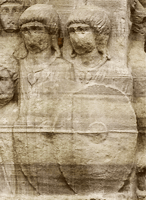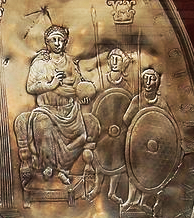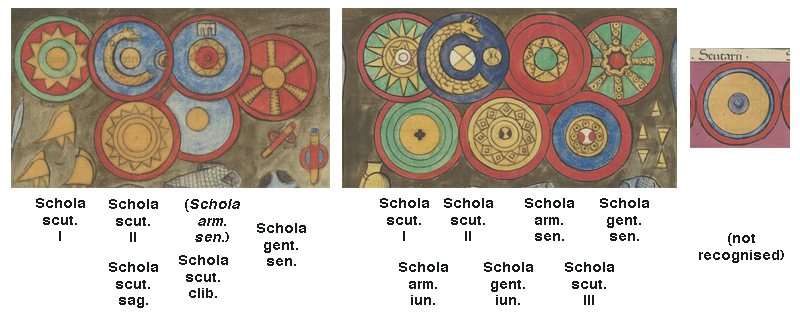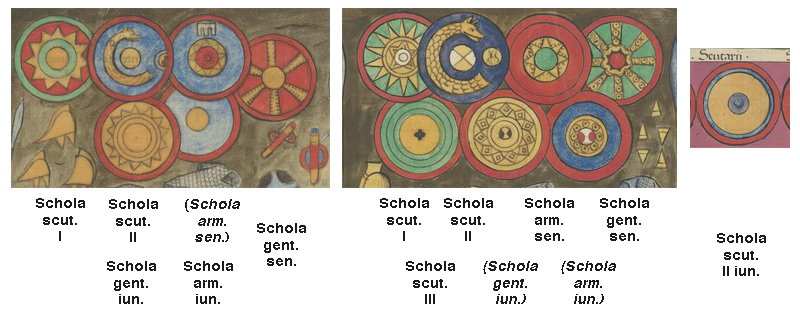
This page created 15 April 2014, and last modified: 29 April 2015 (commentary about possible pattern-unit identifications updated)

There are 13 units listed in the Notitia entitled Scholae:
|

|
The figures on the left are carved into the base of the Column of Theodosius in Istanbul. Their shields have only 2-fold and not 4-fold symmetry, as they are longer below the boss than above it. These particular examples, being smaller than usual, probably belong to cavalrymen; the neck torques make one suspect the bearers might belong to the Scholae, since these horseguards included many soldiers with ethnic German origins. This teardrop-like shield would become more common as the millennium progressed, and also become more elongated, eventually evolving into the medieval "kite" shield.
Photo by Simon Macdowall and used with kind permission of the author. |
The Equites scutarii iuniores scholae secundi would appear to be the same units as the Equites secundi scutarii iuniores, a comitatenses vexillation listed (102/5.40) under the Magister Equitum, and whose shield pattern is thus recorded in the Notitia under the plain label (101.s) Scutarii.
The illustrations accompanying each of the two Masters of the Offices show shield patterns, but unlike the illustrations that accompany the lists of units under normal field commanders, these are not labelled with specific unit names. Indeed, it is not certain that their accompanying shield patterns are even intended to represent the units under their command, because the two Magistri also have jurisdiction over armaments manufacturies called "fabricae", and the one word accompanying the depicted shields (and swords, spears, helmets and other armaments...) is none other than "Fabricae". See my separate pages for the two Magistri, the eastern Magister Officiorum and the western Magister Officiorum, for more details.
Assuming the shield patterns do, in fact, represent the Scholae units of the Magistri (and this is no small assumption), then the shield patterns of these "13" units are as shown below, using the pictures taken from the Paris manuscript (note that they amount to 14 patterns):

|
Pattern 106#5 clearly features a round imago (imperial portrait), a standard feature of Roman military standards; the draco shown on the shield would also appear to be a reference to a military standard. Parallel pattern 22#4 likewise features both a draco and a round imago, albeit partially obscured by the shield's rim. I would interpret the somewhat M-shaped device of 22#5 as another imago, this one rectangular, and featuring the images of two personages, but reproduced crudely, partially due to its small size (cf. the pattern of the Tertia Diocletiana Thebaeorum (18.15) under the Magister Militum per Thracias).
Scholae guards units are attested in a 389 AD legal reference (Cod. Theod. 14.17.9) as being in existence as early as Constantine's reign ("annonas civicas in urbe Constantinopolitana scholae scutariorum et scutariorum clibanariorum divi Constantini adseruntur liberalitate meruisse"; Constantine died in 337), and are frequently found in the thick of the action in Ammianus' historical account of the third quarter of the fourth century; thus they appear to have been genuine military units at the time of the Notitia, and not just ceremonial guards. Note however that both the eastern and western Magistri each have one other Scholae "unit" under their command not listed above - a "Schola agentes in rebus et deputati euisdem scholae" - i.e. a cadre of senior civil servants and their assistants. Clearly these particular "units" were not combat formations! One of the shield patterns shown for the western Magister, that of 106#7 at the top right, looks somewhat similar to that carried by a guardsman shown in the famous Justinian mosaic in the San Vitale basilica in Ravenna (see right). Both feature a green field with golden decorated rays, although in the case of the 6th-century mosaic, there are only six, as they form a chi-rho monogram, while there are 8 in the Notitia manuscripts (or, at least in O, P, and W: there are indeed just 6 rays in M). The eastern Magister has a shield featuring a 6-rayed emblem: 22#6, but it is on a red ground (or white, in the case of M). All in all, the similarities are intriguing, but not so close as to make a convincing case for identity. In fact, the Notitia as it has come down to us is notable for its complete lack of chi-rho symbolism, as this motif is the most commonly depicted in other contemporary sources depicting soldiers accompanying emperors. |

Public domain image |
|
Closer to 106#7 would appear to be a pattern shown on the so-called Missorium of Theodosius - a silver plate that is now displayed (in replica) at the Museum of Merida; the original is dated to either 388 or 393 (two other such guards appear in the other half of the plate).
Two of the four guards bear a shield with apparently 8 rays, one on each side of the emperor. The picture detail shown to the right shows one of these two guards, along with one of the other two guardsmen, who bears an apparently scaled shield. Again, this is a pattern attested elsewhere but not in evidence in the Notitia. It should be noted that the shield pattern for the most senior of the western vexillationes comitatenses, the Equites armigeri (102/5.13) bears a pattern that is somewhat similar in showing an 8-rayed device, as a comparison of the following patterns below, taken from the Parisian manuscript, P, shows: |

Photo by Manuel de Corselas, and released into the public domain. |

Both the western and eastern Magistri Officiorum have a single unit entitled, not armigeri, but the closely related term armaturarum (see my discussion on armigeri for more details): the Schola armaturarum seniorum in the west, and the Schola armaturarum iuniorum in the east. Thus it might be possible to tentatively assign the western pattern 106#7 to the Schola armaturarum seniorum (107.4), and due to its similarity, the eastern pattern 22#6 to the Schola armaturarum iuniorum (23.7).
Inscriptional evidence for what could be either the Schola armaturarum seniores or iuniores comes from the cemetery at Colonia Iulia Concordia (modern Portogruaro in Veneto, Italy), which produced an inscription (ILS 497) mentioning a unit in the form of the NUMERO ARMATURARUM. The seniores is most likely from a geographical argument, but the iuniores cannot be ruled out given Theodosius I's campaign in the area in 394 against Eugenius. See here for Hoffmann's 1963 analysis (in German). It should be noted that in Ammianus' history, armaturae are never described as being Scholae, implying they were still attached to the comital forces in the 370s (note that Ammianus uses the word not just to describe a particular Roman cavalry unit, but also infantry and non-Romans). This contrasts with the gentiles and the scutarii, which are clearly part of the Scholae by the 360s (but perhaps not in the early 350s, where they are seemingly contrasted with the Scholae; Ammianus 14.7.9). Both the eastern and western halves of the empire had units of gentiles et scutarii in the 360s (Ammianus 20.4.3; 20.8.13). Ammianus mentions both a Schola scutariorum prima and secunda as existing in 362 at the latest (Ammianus 20.11.2), but makes no mention of any tertia unit.
An inscription (CIL 5.6726) from Vercelli in northern Italy mentions a [.]COLA ARME[... ...]MA EQUITES SENI[...], which has been expanded to read "[s]cola Arme[niorum pri]ma equitis seni[oris]", which not only does not conform to any of the scholae units listed in the Notitia, but introduces a highly unlikely (to my mind) ethnic title into a Scholae unit. I suspect this might be better read as "[s]cola Arm[a][turarum pri]ma equitis seni[oris]": the drawing in the relevant CIL volume seems to indicate the stone is broken off at the "E" in "ARME", so the "E" is not clear (I have not been able to locate a photograph to check this, however). Neither of these interpretations corresponds exactly with any of the Notitia entries, but the inclusion of prima, if accurate, implies the existance of a secunda, at least.
In addition to the Cod. Theod. 14.17.9 legal reference mentioned above, a soldier from the Schola scutariorum clibanariorum is mentioned in a 5th-century inscription from Syria (SEG 20,332; in Greek) as a "skoutarios klibanarios". In contrast, the Schola scutariorum sagittariorum does not appear to be securely attested anywhere other than the Notitia, although it may well be covered by some of the many references in Ammianus to plain Scutarii; the most likely such example is Ammianus 31.12.16, referring to officers commanding the "sagitarii et scutarii".
Below are the shield patterns from various manuscripts shown together for comparison purposes. Those under O are taken from the Bodleian manuscript; those under P from the Parisian manuscript; those under M from the first half of the Munich manuscript; those under W from the second half of the Munich manuscript; those under B from the printed Froben edition (note that the western ones are in the position the eastern ones should be, and the eastern ones themselves are missing); and those under N from the Norwich folio copies of the dismembered Cambridge manuscript (those of N have very poor resolution as they have been blown up to match the scale of the others from a very small image).

Whether the units listed under the two Magistri that share the same names are different units entirely, or the same units separated by time as well as space, is unclear. In favour of the first interpretation is the observation that named units in the Notitia that have an identically named entry in both the eastern and western halves of the Notitia and have patterns recorded for both entries, have different patterns recorded, and in some cases, its is know from extrinsic evidence the two units really were different units, e.g. the eastern and western Cornuti (seniores), and it might well then be the case that many, perhaps even most, of the other less-well attested apparently duplicated units were similarly in reality different.
Secondly, when units listed in the Notitia are attested in other sources, it can be seen that while literary sources (such as Ammianus) tend to abbreviate the names found in the Notitia, epigraphic ones tend to expand on them. The two Cornuti units just mentioned are a case in point - Ammianus never appends distinction seniores to their names. The Notitia appends seniores to only the western Cornuti unit, but the eastern unit is also attested as seniores in the epigraphic record. Thus two units that apparently bear the same (abbreviated) names in the Notitia might well have actually borne different unabbreviated names - names that perforce must also be unattested - and thus be different units. Without other evidence, we would have no way of knowing. So we cannot even say "their names are the same", let alone "they are the same unit", just "their names are the same in the Notitia" (with the usual caveat of "as it has come down to us").
Another potential argument in favour of the first interpretation is that it might seem wasteful to assign units new shield (pattern)s every time they were transferred from one command to another, thus implying units with different shield patterns are different units, even if named similarly/the same. However, there is plenty of evidence in the Notitia that units that were transferred from a limitanei force, at least, to a comital command were assigned new shield (pattern)s. Rationales for this are not so hard to find. Since limitanei units were essentially permanently stationed (note - this does not mean they were immobile), they were provided with the necessary resources to procure their own equipment - by either fashioning it themselves, or dispatching officers to purchase it. Field army units could not do this, since they lacked a permanent base, and seemingly had to be provided with gear from the imperial fabricae. Since being assigned to a field command meant would have meant being assigned to a new fabricae no matter whether the units was being drafted from a limitanei force or another field command, their would have been no particular reason not to adopt a new shield pattern if the unit was going to be sourced with different shields anyway. So this argument is weakened considerably. Nonetheless, the other points hold.
In favour of the second interpretation, that "different" units bearing the same names are in fact not different units at all, but duplications separated in space and/or time, is the obvious fact that various parts of the Notitia were compiled at different times, and the fact that we know many units were transferred from one station to another - and sometimes moved very considerable differences (e.g. from the lower Danube to Morocco). Thus it would be very surprising if there were no duplicates in the units listings.
Be that as it is, as far as matching units to shields is concerned it makes no difference. We do not need to know if the unit named X matched to shield Y is the same or different unit as the unit X matched to shield Z, only that Y and Z are matched to (an) X, as opposed to matched to units V or W. Only if we also wanted to know how many units there were in total at any point in time would it make a difference how many "different" Xs there were (this is of course a very important question, just not relevant here).
As noted above, pattern 106#7 looks rather similar to that of the Equites armigeri. I would thus tentatively identify the western pattern 106#7 with the western armaturarum unit, the Schola armaturarum seniorum (107.4). Likewise, the similarity of 22#6 with 106#7 would lead me to assign the eastern pattern 22#6 to the eastern unit, the Schola armaturarum iuniorum (23.7).
Given the presence of shields bearing dracos, it might be tempting to assign these to units of gentiles. The introduction of the draco as a standard in the Roman army was under barbarian influence, although it had apparently spread throughout the Roman army by the time of the compilation of the Notitia, since the roughly contemporary Vegetius describes (2.13) each legionary cohort having its own standard, kept by a draconarius. Nonetheless, it seems to have remained more associated with cavalry units than infantry, especially guards cavalry (like Scholae, who had a high proportion of foreign troopers); the purple draco borne by the emperor Julian's horseguards at the battle of Argentoratum in 357 is singled out by Ammianus, for example, and the Notitia itself has a much higher proportion of cavalry shields depicting dracos than infantry shields (6 out of 54 compared to 2 out of 230, giving an occurrence frequency more than 12 times greater for cavalry than infantry). Thus the units of gentiles among the Scholae would seem especially suitable candidates for matching with these shields. Unfortunately, there are just two shields bearing dracos, but three units of gentiles among the Scholae (plus an implied missing fourth unit, of western Schola gentilium iuniorum). If they do indeed pair up with one another, this means one of the units, in the east, must not have its shield pattern depicted. It might be possible to assign the western Schola gentilium seniorum unit (107.5) to pattern 106#5; albeit tentatively, since this is the only unit of gentiles listed under the western Magister. Of the two eastern units, I might assign the pattern 22#4 to the Schola gentilium seniorum (23.4) since it is the higher ranked in the textual list than the Schola gentilium iuniorum (23.8), and thus more likely than not to correspond to a shield positioned so highly in the corresponding picture. However, it is more likely to my mind that the equation between dracos and gentiles is false; in particular, it makes any inferences on shield pattern position and unit list position very tenuous, given the high pictorial position of the patterns and the low textual position of the units.
Barlow & Brennan (Classical Quarterly 51.1 (2001), 237-254) took it for granted the shields represented units, and hypothesized an assignment of them as follows (at p241):

positing the loss of an eastern Schola armaturarum seniorum and the transferral of the Schola armaturarum iuniorum and the Schola gentilium iuniorum from the west (as depicted in the pictures) to the east (to give the textual list). They recognised the top rows of each picture contain obvious parallels, but strangely denied any correspondence between the bottom rows, despite the clear similarities between 22#7 and 106#9 in particular, and a lesser, but still to my eyes obvious degree of similarity between 22#8 and 106#10. They also failed to recognise the existence of the Equites scutarii iuniores scholae secundi (as shown by the statement to which their note 5 refers). They also did not say anything about how their acceptance of two different units of Schola gentilium seniorum implied two different units of Schola gentilium iuniorum, despite only one being listed. Any tentative assignment invoking the loss of a putative eastern Schola armaturarum seniorum should at least acknowledge this.
Nonetheless, their top-row assignations look plausible. If I had to give a "most likely" assignation, I might go for something like this:

with the eastern Schola scutariorum sagittariorum and Schola scutariorum clibanariorum being un-illustrated, and no unit transfers required.

Return to the Notitia index page.